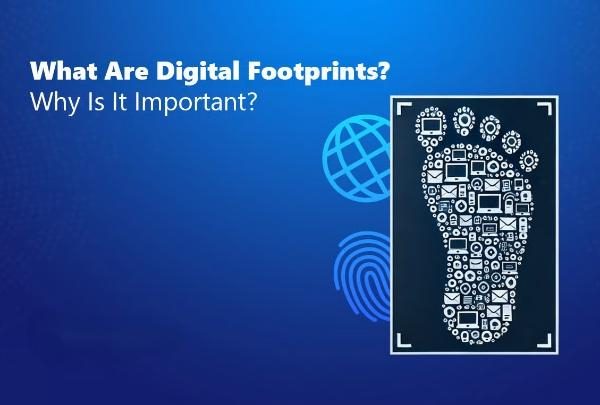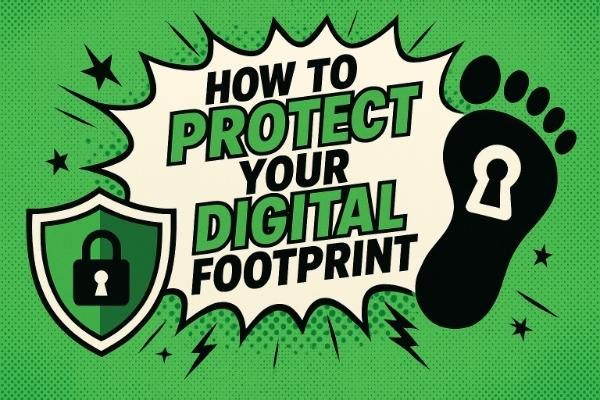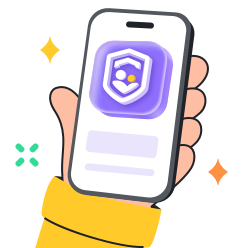What is a digital footprint? Digital footprint means the track you create on the internet by doing online activities, whether on websites, social media, applications, or other internet-based communications. With the advent of the digital age, it is important to know your footprint in terms of safeguarding your privacy and reputation. This guide will explain what a digital footprint is, its different types, how to check yours, why it is so important, and how to manage and protect it, both for adults and children. Backed up with the latest and official statistics, the following article will give a clear understanding of why anyone needs to be conscious of their digital trail.
What is a digital footprint?
Digital footprint refers to the data record when you are using the internet and digital devices. It encompasses everything you do online, whether intentionally or unintentionally, such as the information you consciously share and the data gathered as you browse websites or use applications.
As an example, posting a picture on social media, commenting on a blog post, or online shopping will add to your digital footprint. Even when you do not actively distribute information, e.g., the track of your browsing habits comes through websites or information regarding your app usage. There is always a digital trace that you leave.
Digital footprints are formed both by adults and children. Children in particular, however, might be less informed of just how much information they are sharing and how accessible or easily misused it is. This highlights the significance of parental control for online child safety. Since the younger generation uses the internet more often, there is an urgency in learning how a digital footprint works.
Types of digital footprints
Digital footprints are usually classified into two different categories, namely active and passive. Learning the difference is critical when learning how to best manage your online presence.
Active digital footprint
An active digital footprint is the collected data consisting of information you provided and shared via an online platform. For example, you contribute to your active footprint when you fill in your social media profile, post your photos, tweet, comment on a post, and send emails. Your choice to provide this information is made consciously, and that is why you have some control over this information. But even if you delete this information, it may be archived or saved by others, and it is therefore important to consider what you post.
People can usually detect and manage active digital footprints easily. Privacy settings on most social media websites give you the option to restrict who gets access to your posts and profile. The reason is that this footprint is generated under direct involvement, which is reflective in terms of your personality, interests, and social affiliations. It may be a good thing when responsibly applied, e.g, to professional networking or career accomplishments.
Passive digital footprint
Websites and systems create passive digital footprints without your explicit input or knowledge. This comprises information gathered without any input on your part; examples of this data are tracking cookies, device, IP addresses, and search histories. Websites and advertisers gather this information to study your behavior and show content or ads that may interest you.
You do not directly share this information, and most of the time, you cannot see it. An example of this would be something as benign as opening up a webpage or reading an email, which would create a passive footprint. Passive data collection necroses are less controllable and harder to contain compared to active footprints. You can mitigate this data collection through browser privacy settings, the use of ad-blockers, or virtual private networks (VPNs).
How can I see my digital footprint?



By having a look at your digital footprint, you will understand what your online presence looks like, and it will also highlight the threats to your privacy. Start by following these steps.
Search engines
The easiest one is to type in your full name in the most popular search engines such as Google, Bing, and DuckDuckGo. Inspect the first three pages of the results thoroughly with the web browser for any reference to your name, even in social media accounts and new ones, as well as in personal photos and blogs, or directories.
Note down anything outdated or sensitive that may impact our reputation/privacy. Take screenshots of the outcome to monitor your online presence throughout time.
Social profiles
Sign into all social networks in which you ever participated, Facebook, Instagram, TikTok, Twitter (X), LinkedIn, Snapchat, and so on. Look at your profiles as though you were a hacker seeking out sensitive or personal data such as a phone number, email address, location details, or birthday. Look at your posts, tagged photos, comments, and other online engagements from a third-person perspective.
Do not forget to review your friend/follower lists. Take a closer look at unknown contacts, as they may end up giving you more exposure. Ensure that you use the right privacy settings on each platform to determine who can see your profile and activity.
App activity
Check your phone, tablet, or computer settings to see the apps with access to your personal information, such as location, contacts, camera, and microphone. Remove access to those apps that are not necessary or invasive.
Most apps ask to access a variety of data, even though they have no intention to use it to perform the main functions. By limiting them, they will not be able to gather passive data, and improve your security.
Digital services
Most online services now allow you to create a copy of your data, listing your posts, messages, searches, and locations. For example, both Facebook and Google have tools to export your data.
It can be an eye-opener to access this information. You might see something sensitive or long forgotten held on the web, even decades after publishing.
Browser history
When using an internet browser, make sure that you clear your browsing history, stored cookies, and cached data frequently. Use incognito or private browsing mode when browsing online so you can spot what your public presence is like without it being personalized to you. Install privacy-centered browser extensions and block trackers and invasive advertisements. By taking these measures, you can reduce the data being collected.
Data brokers
A lot of firms and sites use and sell information about individuals to marketers and advertisers. Search online to find where data brokers publicly list your information. Some brokers give you the right to remove that data.
By learning about these third-party sources, you will grasp the extent of your publicly shared information.
Email and passwords
Look up sites where your private information may have been compromised (e.g., email or passwords). Protect weak credentials by resetting passwords and by turning on two-factor authentication.
The steps listed above will allow you to understand your digital footprint and what it takes to manage it properly.
Monitor your child’s online activity to maintain a positive digital footprint.
Why is a digital footprint important?



Your digital footprint carries a lot of weight when it comes to privacy, security, reputation, and safety. We are examining all these factors using modern information and figures:
Privacy concerns
Bad actors can intercept, store, and maliciously use everything you share online. A study released by ALSPAC in 2024 indicated that the real-time tracking of user preferences and behaviors can be conducted in detail thanks to the digital footprint records. Such a degree of surveillance poses a threat to fundamental digital privacy rights.
For children, the risks are even more serious. According to a report by the United Nations, 8 out of 10 children have already made their digital footprint before reaching the age of two, most of the time through the photos or posts made by their parents. This exposes them to identity risks and privacy issues.
Kids safety
The issue of online safety is increasing among children. According to a study by Common Sense Media, 45 percent of teens saw something inappropriate on Snapchat. Moreover, according to the National Center for Missing and Exploited Children, it was found that more than 370,000 child exploitation cases were reported on social networks, including Twitter (X), at the beginning of 2024.
Cyberbullying, grooming, phishing, and exposure to harmful media are still dangerous factors. More than 50 percent of parents in the United States have resorted to the use of monitoring apps to track the online activities of their kids, which is a move that they need to take following the worrying figures of online abuse.
Career & learning implications
A digital footprint is a major factor for educational opportunities as well. According to a CareerBuilder report, 70% of employers research social media about job applicants in the hiring process. Colleges also consider the online behavior of the applicant, and some retract offers depending on their worrisome online content.
Keeping a professional and clear digital footprint will boost your standing, and you will be more believable in the eyes of employers and academic institutions.
Identity theft
Cybercrime and identity theft are some of the long-term risks produced by the over-sharing of personal information. According to the U.S. Federal Trade Commission, cases of identity theft have also increased substantially in 2023, with a lot of it being through the misuse of data on social media.
Criminals can more easily send phishing emails and commit fraud when people overshare. Pay close attention to your online image to decrease such risks.
Data profiling
Companies often collect your data to run targeted ads and behavioral analytics. According to the Pew Research Center, 81 percent of Americans do not believe they have control over the use of their digital information by companies.
Sharing data may permanently leave a copy somewhere on servers or backups, even with deletion attempts. Such loss of control emphasises the effectiveness of good privacy measures.
Legal/ethical issues
Regulations like the COPPA (Children Online Privacy Protection Act) and GDPR (General Data Protection Regulation) are laws in many nations to safeguard the information of minors and citizens. Data security of children is not only about their privacy; rather, it is a legal obligation of the ones who take the responsibility of the children, i.e., their parents and guardians.
How to manage your digital footprint (and your kid’s)?



Managing digital footprints is an ongoing process. Parents and children must take action to control how they are represented online.
For parents:
- Regularly check social media privacy settings to keep profiles private and restrict sensitive data.
- Put age limits on gadgets and programs.
- Parents should track the applications their children download and use. Remove or set restrictions on harmful apps.
- Turn off GPS when not needed to restrict location sharing.
- Install parental control programs like FlashGet Kids to monitor and get alerts in real time. This app offers features like social media tracking, screen mirroring, notification detection, keyword alerts, and much more!
- Start teaching about digital risks and online etiquette to kids at a young age.
- Use strong and different passwords for all the family accounts through password managers.
- Keep up with the news of newly emerging privacy tools.
- Discuss privacy and cyberbullying.
- Keeping the accounts and devices clean by deleting old or dormant profiles.
For kids:
- Think before sharing. Ask yourself whether the post or the photo will expose sensitive information.
- Guard personal data. Do not share your address, cellphone, or even school or day-to-day activities.
- Make social media accounts private. Only connect with the people that you know and trust.
- Use strong passwords and keep them hidden.
- Seek permission from parents to download or share new applications and content.
- Report bullying, harassment, or suspicious messages immediately.
- Restrict the amount of time spent in front of a screen.
- Strive for a balance between online and offline activities.
- Delete unnecessary posts to reduce your digital footprint.
- Learn about privacy tools. Use trusted apps to manage your data.
- Keep in mind that online information could be everlasting!
FAQs about digital footprints
Yes. It includes uploaded videos and also watched and liked content. TikTok also gathers data on geographical location, devices, and interaction metrics.
Completely erasing your digital footprint is next to impossible. Even if you delete accounts and posts, companies or others may still keep some data.
A digital footprint is neutral in and of itself. The value of your digital footprint depends on what you post and how you control it. There is a good footprint that can help build a career, relationships, and personal branding.

